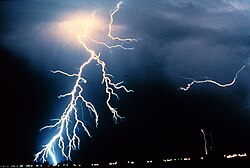
Back شرارة كهربائية Arabic Qığılcım Azerbaijani Іскравы разрад Byelorussian Хĕлхемлĕ хухăм CV Funke (Entladung) German Chispa eléctrica Spanish Sädelahendus Estonian جرقه الکتریکی Persian Sähkökipinä Finnish Կայծային պարպում Armenian


An electric spark is an abrupt electrical discharge that occurs when a sufficiently high electric field creates an ionized, electrically conductive channel through a normally-insulating medium, often air or other gases or gas mixtures. Michael Faraday described this phenomenon as "the beautiful flash of light attending the discharge of common electricity".[1]
The rapid transition from a non-conducting to a conductive state produces a brief emission of light and a sharp crack or snapping sound. A spark is created when the applied electric field exceeds the dielectric breakdown strength of the intervening medium. For air, the breakdown strength is about 30 kV/cm at sea level.[2] Experimentally, this figure tends to differ depending upon humidity, atmospheric pressure, shape of electrodes (needle and ground-plane, hemispherical etc.) and the corresponding spacing between them and even the type of waveform, whether sinusoidal or cosine-rectangular.
At the beginning stages, free electrons in the gap (from cosmic rays or background radiation) are accelerated by the electrical field, resulting in a Townsend avalanche. As they collide with air molecules, they create additional ions and newly freed electrons which are also accelerated. At some point, thermal energy will provide a much greater source of ions. The exponentially-increasing electrons and ions rapidly cause regions of the air in the gap to become electrically conductive in a process called dielectric breakdown. Once the gap breaks down, current flow is limited by the available charge (for an electrostatic discharge) or by the impedance of the external power supply. If the power supply continues to supply current, the spark will evolve into a continuous discharge called an electric arc. An electric spark can also occur within insulating liquids or solids, but with different breakdown mechanisms from sparks in gases.
Sometimes, sparks can be dangerous. They can cause fires and burn skin.
Lightning is an example of an electric spark in nature, while electric sparks, large or small, occur in or near many man-made objects, both by design and sometimes by accident.
- ^ Faraday, Experimental Researches in Electricity, volume 1 paragraph 69.
- ^ Meek, J. (1940). "A Theory of Spark Discharge". Physical Review. 57 (8): 722–728. Bibcode:1940PhRv...57..722M. doi:10.1103/PhysRev.57.722.
© MMXXIII Rich X Search. We shall prevail. All rights reserved. Rich X Search